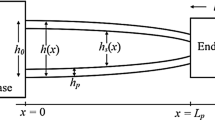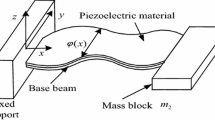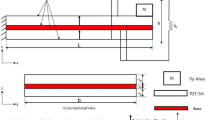Abstract
This work is focused on low frequency (<300 Hz) vibrations due to the fact that many industrial and commercial devices operate at those frequencies. The aim of the present work is to model by numerical simulation a Si cantilever beam with an AlN piezoelectric layer concept that tunes its resonant frequency post-processing, while reducing the separation of the first two modes of resonance in order to broaden its quality factor and, therefore, to harvest more environmental energy. This paper investigates by numerical simulation the influence of perforating sections of the Si beam has on the resonant frequencies of the cantilever. The authors have found that the distance between these modes is decreased by 30 % when 0.002 mm3 is extracted in a specific location of the initial structure. This difference between modes can be reduced above 80 % if a volume of 0.004 mm3 in a specific part of the initial design is subtracted. In these conditions, the first mode is decreased about 20 % the initial value and the second mode about 60 %.








Similar content being viewed by others
References
Anton SR, Sodano HA (2007) A review of power harvesting using piezoelectric materials (2003–2006). Smart Mater Struct 16:R1
Choi D-H, Han C-H, Kim H-D, Yoon J-B (2011) Liquid-based electrostatic energy harvester with high sensitivity to human physical motion. Smart Mater Struct 20:125012
COMSOL Multiphysics (2008) Structural mechanics module. User’s Guide, Version 4.2
COMSOL Multiphysics (2012) 4.3 User’s guide. COMSOL
Elfrink R, Kamel TM, Goedbloed M, Matova S, Hohlfeld D, Van Andel Y, Van Schaijk R (2009) Vibration energy harvesting with aluminum nitride-based piezoelectric devices. J Micromech Microeng 19(9):094005. doi:10.1088/0960-1317/19/9/094005
Emam M (2008) Finite element analysis of composite piezoelectric beam using comsol. M.S. thesis, Drexel University, Philadelphia
Ericka M, Vasic D, Costa F, Poulain G (2005) Predictive energy harvesting from mechanical vibration using a circular piezoelectric membrane. In: IEEE Ultrasonics Symposium, vol 2, pp 946–949
Horowitz S, Nishida T, Cattafesta L, Sheplak M (2007) Development of a micromachined piezoelectric microphone for aeroacoustics applications. J Acoust Soc Am 122:3428–3436
Jackson N, O’Keeffe R, O’Leary R, O’Neill M, Waldron F, Mathewson A (2012) A diaphragm based piezoelectric AlN film quality test structure. In: Microelectronic test structures (ICMTS), 2012 IEEE international conference. IEEE, pp 50–54
Jackson N, O’Keeffe R, Waldron F, O’Neill M, Mathewson A (2013) Influence of aluminum nitride crystal orientation on MEMS energy harvesting device performance. J Micromech Microeng 23:075014
Jackson N, O’Keeffe R, Waldron F, O’Neill M, Mathewson A (2014) Evaluation of low-acceleration MEMS piezoelectric energy harvesting devices. Microsyst Technol 20:671–680
Kong LB, Li T, Hng HH, Boey F, Zhang T, Li S (2014) Waste mechanical energy harvesting (I): piezoelectric effect. In: Waste energy harvesting. Springer, Berlin, Heidelberg, pp 19–133
Mehraeen S, Jagannathan S, Corzine K (2008) Energy harvesting using piezoelectric materials and high voltage scavenging circuitry. In: IEEE international conference on Industrial technology, 2008 (ICIT 2008). IEEE, pp 1–8
Meninger S, Mur-Miranda JO, Amirtharajah R, Chandrakasan AP, Lang JH (2001) Vibration-to-electric energy conversion. Very Larg Scale Integr (VLSI) Syst IEEE Trans 9:64–76
Miller LM, Halvorsen E, Dong T, Wright PK (2011) Modeling and experimental verification of low-frequency MEMS energy harvesting from ambient vibrations. J Micromech Microeng 21:045029
O’Keeffe R, Jackson N, Waldron F, O’Niell M, McCarthy K, Mathewson A (2013) Investigation into modelling power output for MEMS energy harvesting devices using COMSOL Multiphysics R. In: 14th international conference on thermal, mechanical and multi-physics simulation and experiments in microelectronics and microsystems (EuroSimE), 2013. IEEE, pp 1–6
Rivadeneyra A, Lopez-Villanueva JA, O’Keeffe R, Jackson N, O’Neill M, Mathewson A (2012) Frequency response of variants of a cantilever beam. In: International conference on synthesis, modeling, analysis and simulation methods and applications to circuit design (SMACD). IEEE, pp 177–180
Roundy S et al (2005) Improving power output for vibration-based energy scavengers. Pervasive Comput IEEE 4:28–36
Zhu D, Tudor M, Beeby S (2010) Strategies for increasing the operating frequency range of vibration energy harvesters: a review. Meas Sci Technol 21:022001
Acknowledgments
This work was partially funded by the Junta de Andalucía, Spain (Proyecto de Excelencia P10-TIC-5997), Research contract TECNOCAI (Ministry of Science and Technology, Spain) and the Collaborative Centre for Applied Nanotechnology (CCAN) as part of the Irish Government’s Strategy for Science Technology and Innovation 2006–2013.
Author information
Authors and Affiliations
Corresponding author
Rights and permissions
About this article
Cite this article
Rivadeneyra, A., Soto-Rueda, J.M., O’Keeffe, R. et al. Tunable MEMS piezoelectric energy harvesting device. Microsyst Technol 22, 823–830 (2016). https://doi.org/10.1007/s00542-015-2455-1
Received:
Accepted:
Published:
Issue Date:
DOI: https://doi.org/10.1007/s00542-015-2455-1




